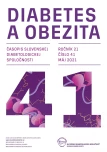Discordance between blood glucose and HbA1c – is an explanation possible according to the biokinetic model of glycation?
Authors:
Oliver Rácz 1; Peter Dombrovský 1; Vladimír Heriban 2; Marek Brenišin 1; Katarína Muriová 3
Authors‘ workplace:
Ústav patologickej fyziológie LF UPJŠ v Košiciach
1; Všeobecná zdravotná poisťovňa, a. s., Bratislava
2; Nemocnica Poprad, a. s., Poprad
3
Published in:
Diab Obez 2021; 21(41): 16-22
Category:
Reviews
Overview
According to the biokinetic model of hemoglobin glycation, hyperglycemic episodes occured recently have a greater impact on HbA1c levels as compared with those occured long ago. In the first part of this paper there are theoretical calculations of HbA1c for stable blood glucose concentrations and for hyperglycemic episodes lasting 24 and 60 days occuring in different time before HbA1c measurement. The second part is devoted to analysis of discordance between blood glucose values and HbA1c assessed as glycation gap and glycation index in 158 patients with diabetes mellitus. The differences of HbA1c calculated according to the biokinetic model and timing of hyperglycemic episodes can probably explain the discordance between blood glucose values and HbA1c.
Keywords:
biokinetic model – diabetes mellitus – glycation index – glycation gap – HbA1c
Sources
- Rácz O, Futáš E, Kuzmová D, Reiter et al. Význam matematického modelu glykácie hemoglobínu pre diabetologickú prax. In: Zborník súhrnov IX. patofyziologického kongresu. Košice 1987: 27.
- Rácz O, Vícha T, Pačin J. Glykohemoglobín, glykácia bielkovín a diabetes mellitus. Osveta: Martin 1989. ISBN 80–217–0072–6.
- Campbell L, Pepper T, Shipman K. HbA1c: a review of non-glycaemic variables. J Clin Pathol 2019; 72(1): 12–19. Dostupné z DOI: <http://dx.doi.org/10.1136/jclinpath-2017–204755>.
- Soros AA, Chalew SA, McCarter RJ et al. Hemoglobin glycation index: a robust measure of hemoglobin A1c in pediatric type 1 diabetes patients. Pediatric Diabetes 2010; 11(7): 455–461. Dostupné z DOI: <http://dx.doi.org/10.1111/j.1399–5448.2009.00630.x>.
- Rodriguez-Segade S, Rodríguez J, García Lopez JM et al. Estimation of the glycation gap in diabetic patients with stable glycemic control Diabetes Care 2012; 35(12): 2447–2450. Dostupné z DOI: <http://dx.doi.org/10.2337/dc11–2450>.
- van Steen SC, Schrieks IC, Hoekstra JB et al. The haemoglobin glycation index as predictor of diabetes-related complications in the AleCardio trial. Prevent Cardiol 2017; 24(8): 858–866. Dostupné z DOI: <http://dx.doi.org/10.1177/2047487317692664>.
- Hempe JM, Liu S, Myers L et al. The hemoglobin glycation index identifies subpopulations with harms or benefits from intensive treatment in the ACCORD trial. Diabetes Care 2015; 38(6): 1067–1074. Dostupné z DOI: <http://dx.doi.org/10.2337/dc14–1844>.
- Feng L, Nian S, Zhao Y et al. Higher HbA1c and/or glucose levels alter the association patterns between glycated hemoglobin and fasting glucose levels. Diab Res Clin Pract 2018; 142: 353–362. Dostupné z DOI: <http://dx.doi.org/10.1016/j.diabres.2018.06.011>.
- Nayak AU, Singh BM, Dunmore SJ. Potential clinical error arising from use of HbA1c in diabetes: effects of the glycation gap. Endocrine Rev 2019; 40(4): 988–999. Dostupné z DOI: <http://dx.doi.org/10.1210/er.2018–00284>.
- Beach KW. A theoretical model to predict the behaviour of glycosylated hemoglobin levels. J Theor Biol 1979; 81(3): 547–561. Dostupné z DOI: <http://dx.doi.org/10.1016/0022–5193(79)90052–3>.
- Mortensen HB, Volund A. Application of a biokinetic model for prediction and assessment of glycated hemoglobins in diabetic patients. Scand J Clin Lab Invest 1988; 48(6): 595–602. Dostupné z DOI: <http://dx.doi.org/10.3109/00365518809085778>.
- Ladyzynski P, Wójcicki JM, Bak M et al. Validation of hemoglobin glycation models using glycemia monitoring in vivo and culturing of erythrocytes in vitro. Ann Biomed Eng 2008; 36(7): 1188–1202. Dostupné z DOI: <http://dx.doi.org/10.1007/s10439–008–9508-x>.
- Ladyzynski P, Wójcicki JM, Bak M et al. Hemoglobin glycation rate constant in non-diabetic individuals. Ann Biomed Eng 2011; 39(11):2721–34. Dostupné z DOI: >http://dx.doi.org/10.1007/s10439–011–0366–6>.
- Ladyzynski P, Foltyński P, Sabalińska S et al. An analysis of the hemoglobin glycation rate in the A1C-derived average glucose study population applying a Monte Carlo method. In: 6th European Conference of the International Federation for Medical and Biological Engineering. IFMBE Proceedings book series (IFMBE) 2015; 45: 435–438. Dostupné z DOI: <https://doi.org/10.1007/978–3-319–11128–5_109>.
- Advani A. Positioning time in range in diabetes management. Diabetologia 2020; 63(2): 242–252. Dostupné z DOI: <http://dx.doi.org/10.1007/s00125–019–05027–0>.
- Virtue MA, Furne JK, Nuttall FQ et al. Relationship between GHb concentration and erythrocyte survival determined from breath carbon monoxide concentration. Diab Care 2004; 27(4): 931–935. Dostupné z DOI: <http://dx.doi.org/10.2337/diacare.27.4.931>.
- Cohen RM, Franco RS, Joiner CH. Is poor glycemic control associated with reduced red blood cell lifespan? Diabetes Care 2004; 27: 1013–1014. Dostupné z DOI: <http://dx.doi.org/10.2337/diacare.27.4.1013>.
- Cohen RM, Franco RS, Khera PK et al. Red cell life span heterogeneity in hematologically normal people is sufficient to alter HbA1c. Blood 2008; 112(10): 4284–4291. Dostupné z DOI: <http://dx.doi.org/10.1182/blood-2008–04–154112>.
- Willekens FL, Roerdinkholder-Stoelwinder YA, Groenen-Döpp HJ et al. Hemoglobin loss from erythrocytes in vivo results from spleen facilitated vesiculation. Blood 2003; 101(2): 747–751. Dostupné z DOI: <http://dx.doi.org/10.1182/blood-2002–02–0500>.
- Delpierre GD, Vertommen D, Communi MH et al. Identification of fructosamine residues deglycated by fructosamine-3-kinase in human hemoglobin. J Biol Chem 2004; 279(26): 27613–27620. Dostupné z DOI: <http://dx.doi.org/10.1074/jbc.M402091200>.
- Dunmore SJ, Al-Derawi AS, Nayak AU et al. Evidence that differences in fructosamine-3-kinase activity may be associated with the glycation gap in human diabetes. Diabetes 2018; 67(1): 131–136. Dostupné z DOI: <http://dx.doi.org/10.2337/db17–0441>.
Labels
Diabetology ObesitologyArticle was published in
Diabetes and obesity

2021 Issue 41
Most read in this issue
- Discordance between blood glucose and HbA1c – is an explanation possible according to the biokinetic model of glycation?
- The potential of induced pluripotent stem cells in the study and treatment of monogenic diabetes
- Today we can influence overweight and obesity – and thus prevent their consequences, as is the development of diabetes or cardiovascular disease
- News in the field of 2nd generation of basal insulin analogs in type 1 diabetes and data from continuous glucose monitoring
